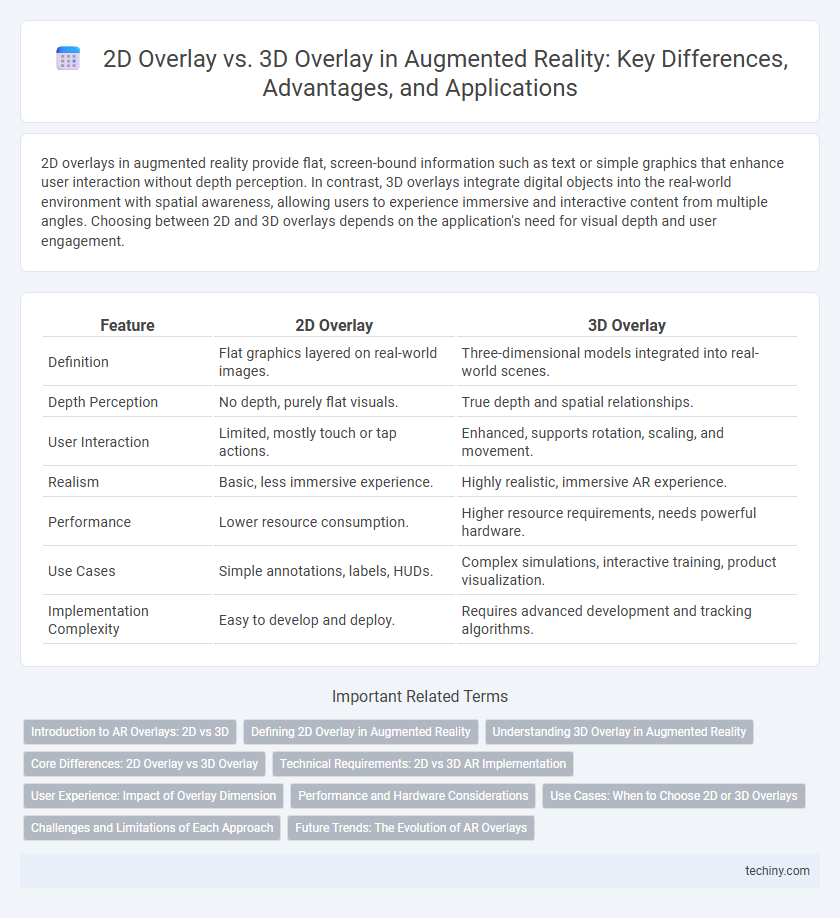2D overlays in augmented reality provide flat, screen-bound information such as text or simple graphics that enhance user interaction without depth perception. In contrast, 3D overlays integrate digital objects into the real-world environment with spatial awareness, allowing users to experience immersive and interactive content from multiple angles. Choosing between 2D and 3D overlays depends on the application's need for visual depth and user engagement.
Table of Comparison
| Feature | 2D Overlay | 3D Overlay |
|---|---|---|
| Definition | Flat graphics layered on real-world images. | Three-dimensional models integrated into real-world scenes. |
| Depth Perception | No depth, purely flat visuals. | True depth and spatial relationships. |
| User Interaction | Limited, mostly touch or tap actions. | Enhanced, supports rotation, scaling, and movement. |
| Realism | Basic, less immersive experience. | Highly realistic, immersive AR experience. |
| Performance | Lower resource consumption. | Higher resource requirements, needs powerful hardware. |
| Use Cases | Simple annotations, labels, HUDs. | Complex simulations, interactive training, product visualization. |
| Implementation Complexity | Easy to develop and deploy. | Requires advanced development and tracking algorithms. |
Introduction to AR Overlays: 2D vs 3D
AR overlays enhance real-world environments by superimposing digital content, with 2D overlays presenting flat images or information directly on the user's view, ideal for straightforward data display and user interface elements. In contrast, 3D overlays integrate three-dimensional models that interact spatially with the environment, offering immersive experiences crucial for gaming, training, and design applications. The choice between 2D and 3D AR overlays depends on the use case requirements, balancing simplicity and contextual depth to optimize user engagement.
Defining 2D Overlay in Augmented Reality
2D overlay in augmented reality involves displaying flat, two-dimensional images or graphics directly onto the user's view of the real world, enhancing the environment with contextual information such as text, icons, or simple animations. Unlike 3D overlays, 2D overlays do not have depth or spatial positioning relative to real-world objects, making them ideal for heads-up displays, menus, and notifications. This approach optimizes user interface clarity and performance in AR applications where complex spatial interactions are unnecessary.
Understanding 3D Overlay in Augmented Reality
3D overlay in augmented reality integrates virtual objects seamlessly into real-world environments by aligning them with physical space, enhancing depth perception and interaction accuracy. Unlike 2D overlay, which simply superimposes flat images on the view, 3D overlay uses spatial mapping and real-time tracking to render holograms that respond to user perspective and movement. Advanced sensors and algorithms enable 3D overlays to provide immersive experiences in applications such as gaming, navigation, and industrial visualization.
Core Differences: 2D Overlay vs 3D Overlay
2D overlays in augmented reality display flat, fixed images or information on the screen, anchored to the device's view but lacking depth perception. In contrast, 3D overlays integrate virtual objects into the physical environment with spatial awareness, enabling interaction from multiple angles and realistic scaling. The core difference lies in dimensionality and immersion, as 3D overlays enhance user engagement through depth and positional tracking, while 2D overlays provide straightforward, often simpler information presentation.
Technical Requirements: 2D vs 3D AR Implementation
2D overlay in augmented reality requires simpler hardware and software, focusing primarily on flat image recognition and tracking with lower computational power and less complex sensors. In contrast, 3D overlay demands advanced depth sensors, spatial mapping, and real-time rendering capabilities to accurately integrate virtual objects within a three-dimensional environment. Effective 3D AR implementation relies on higher GPU processing power, precise camera calibration, and sophisticated SLAM (Simultaneous Localization and Mapping) algorithms to maintain spatial coherence and user interaction fidelity.
User Experience: Impact of Overlay Dimension
2D overlays in augmented reality provide a flat interface that simplifies user interaction by maintaining focus on core information without obstructing the real-world view. In contrast, 3D overlays enhance immersion by seamlessly integrating virtual objects within the physical environment, offering users spatial depth perception and interactive engagement. The choice between 2D and 3D overlays significantly influences user experience by balancing clarity and immersion based on application complexity and user needs.
Performance and Hardware Considerations
2D overlay in augmented reality typically demands less processing power and memory, making it suitable for devices with limited hardware capabilities such as smartphones and lightweight AR glasses. In contrast, 3D overlay requires more advanced GPUs, higher frame rates, and precise sensor integration to render realistic depth and spatial mapping, often relying on AR headsets or powerful mobile devices. Performance optimization for 3D overlays involves balancing polygon count and shader complexity to maintain smooth user experiences without overloading hardware resources.
Use Cases: When to Choose 2D or 3D Overlays
2D overlays excel in applications requiring straightforward information display, such as heads-up displays in automotive HUDs or medical imaging annotations, where simplicity and minimal distraction are crucial. 3D overlays suit complex environments like industrial maintenance, immersive gaming, or architectural visualization, providing spatial context and depth perception to enhance user interaction. Selecting between 2D and 3D overlays depends on task complexity, user environment, and the need for spatial understanding to optimize augmented reality effectiveness.
Challenges and Limitations of Each Approach
2D overlays in augmented reality often face challenges such as limited depth perception and reduced spatial awareness, which can hinder user interaction in complex environments. Conversely, 3D overlays offer immersive experiences but demand higher computational power, precise tracking, and robust hardware to render accurate spatial alignment. Both approaches struggle with occlusion handling and environmental variability, impacting the realism and effectiveness of AR applications.
Future Trends: The Evolution of AR Overlays
Future trends in augmented reality overlays emphasize the shift from 2D to 3D overlays, enhancing spatial awareness and user interaction through depth perception and real-world integration. Advances in AR hardware and software, such as improved sensors and AI-driven content rendering, enable more immersive and context-aware experiences with 3D overlays. The evolution toward dynamic 3D overlays supports applications in gaming, education, and industrial design, driving more intuitive and engaging user interfaces.
2D Overlay vs 3D Overlay Infographic

 techiny.com
techiny.com